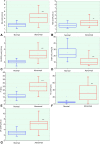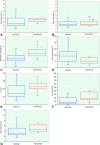Respiratory Oscillometry in Chronic Obstructive Pulmonary Disease: Association with Functional Capacity as Evaluated by Adl Glittre Test and Hand Grip Strength Test
- PMID: 35547780
- PMCID: PMC9081189
- DOI: 10.2147/COPD.S353912
Respiratory Oscillometry in Chronic Obstructive Pulmonary Disease: Association with Functional Capacity as Evaluated by Adl Glittre Test and Hand Grip Strength Test
Abstract
Purpose: Respiratory oscillometry has emerged as a powerful method for detecting respiratory abnormalities in COPD. However, this method has not been widely introduced into clinical practice. This limitation arises, at least in part, because the clinical meaning of the oscillometric parameters is not clear. In this paper, we evaluated the association of oscillometry with functional capacity and its ability to predict abnormal functional capacity in COPD.
Patients and methods: This cross-sectional study investigated a control group formed by 30 healthy subjects and 30 outpatients with COPD. The subjects were classified by the Glittre‑ADL test and handgrip strength according to the functional capacity.
Results: This study has shown initially that subjects with abnormal functional capacity had a higher value for resistance (p < 0.05), reactance area (Ax, p < 0.01), impedance modulus (Z4, p < 0.05), and reduced dynamic compliance (Cdyn, p < 0.05) when compared with subjects with normal functional capacity. This resulted in significant and consistent correlations among resistive oscillometric parameters (R=-0.43), Cdyn (R=-0.40), Ax (R = 0.42), and Z4 (R = 0.41) with exercise performance. Additionally, the effects of exercise limitation in COPD were adequately predicted, as evaluated by the area under the curve (AUC) obtained by receiver operating characteristic analysis. The best parameters for this task were R4-R20 (AUC = 0.779) and Ax (AUC = 0.752).
Conclusion: Respiratory oscillometry provides information related to functional capacity in COPD. This method is also able to predict low exercise tolerance in these patients. These findings elucidate the physiological and clinical meaning of the oscillometric parameters, improving the interpretation of these parameters in COPD patients.
Keywords: COPD physiopathology; Glittre-ADL test; chronic obstructive pulmonary disease; exercise limitation; forced oscillation technique; handgrip strength; respiratory impedance.
© 2022 Ribeiro et al.
Conflict of interest statement
The authors report no conflicts of interest in this work.
Figures



Similar articles
-
Respiratory Oscillometry and Functional Performance in Different COPD Phenotypes.Int J Chron Obstruct Pulmon Dis. 2024 Mar 6;19:667-682. doi: 10.2147/COPD.S446085. eCollection 2024. Int J Chron Obstruct Pulmon Dis. 2024. PMID: 38464561 Free PMC article.
-
Factors Influencing Activities of Daily Living in Subjects With COPD.Respir Care. 2019 Feb;64(2):189-195. doi: 10.4187/respcare.05938. Epub 2018 Nov 6. Respir Care. 2019. PMID: 30401755
-
Evaluation of Exertional Ventilatory Parameters Using Oscillometry in COPD.Int J Chron Obstruct Pulmon Dis. 2020 Jul 13;15:1697-1711. doi: 10.2147/COPD.S260735. eCollection 2020. Int J Chron Obstruct Pulmon Dis. 2020. PMID: 32764915 Free PMC article.
-
What can we learn about COPD from impulse oscillometry?Respir Med. 2018 Jun;139:106-109. doi: 10.1016/j.rmed.2018.05.004. Epub 2018 May 16. Respir Med. 2018. PMID: 29857993 Review.
-
Chronic obstructive pulmonary disease with mild airflow limitation: current knowledge and proposal for future research - a consensus document from six scientific societies.Int J Chron Obstruct Pulmon Dis. 2017 Aug 29;12:2593-2610. doi: 10.2147/COPD.S132236. eCollection 2017. Int J Chron Obstruct Pulmon Dis. 2017. PMID: 28919728 Free PMC article. Review.
Cited by
-
Impulse oscillometry and its independent role in the diagnosis of chronic obstructive pulmonary disease.Heliyon. 2023 Dec 13;10(1):e23627. doi: 10.1016/j.heliyon.2023.e23627. eCollection 2024 Jan 15. Heliyon. 2023. PMID: 38187302 Free PMC article.
-
Respiratory Oscillometry and Functional Performance in Different COPD Phenotypes.Int J Chron Obstruct Pulmon Dis. 2024 Mar 6;19:667-682. doi: 10.2147/COPD.S446085. eCollection 2024. Int J Chron Obstruct Pulmon Dis. 2024. PMID: 38464561 Free PMC article.
References
-
- World Health Organisation. Health topics; 2021. Available from: https://www.who.int/health-topics/chronic-respiratory-diseases#tab=tab_1. Accessed May 28, 2021.
-
- Karkhanis VS, Joshi JM. Spirometry in chronic obstructive lung disease (COPD). J Assoc Physicians India. 2012;60 Suppl:22–26. - PubMed
MeSH terms
LinkOut - more resources
Full Text Sources
Medical

